7 stability ball exercises for building strength and balance
Mix up your workout with a stability ball

If you’ve been looking for a way to add some variety to your workout routine, a stability ball could be the answer.
Stability balls (also called exercise balls, Swiss balls, or physio balls) are inflatable spheres made of thick plastic that typically range between 45 and 85 centimetres in diameter. Often found in medical settings as well as gyms, they’re great for improving mobility, developing better balance, and building muscle strength and endurance — especially for those new to exercise.
But just because stability balls are used with beginners doesn’t mean they can’t put experienced gym rats to the test. Depending on the exercise, using a stability ball can increase overall difficulty by forcing your whole body to (you guessed it) stabilize against an unstable surface. If you thought a push-up was hard, try doing one with your feet propped up on something round and bouncy.
So find a spot on the mat and add these 7 stability ball exercises to your routine. You can incorporate them into your workout sets if you're new to the gym, or use them as a part of your warm-up if you’ve been pumping iron for years.
How to choose the right size stability ball
With a relatively wide range of sizes available, it can be somewhat confusing to select the right stability ball for the job.
Generally, you should choose a stability ball according to your height — use a 45 centimeter ball if you’re under 5’0”, a 55 centimeter ball if you’re between 5’0” and 5’5”, a 65 centimeter ball if you’re between 5’6” and 5’11”, a 75 centimeter ball if you’re between 6’0” and 6’4”, and and 85 centimeter ball if you’re over 6’4”.
Some exercises will require a smaller or larger stability ball depending on your preferred level of difficulty. If you’re unsure of the right size and have the option of trying a few out, select the ball that allows you to keep good form while still providing a challenge.
Sign up to get the BEST of Tom's Guide direct to your inbox.
Get instant access to breaking news, the hottest reviews, great deals and helpful tips.
7 stability ball exercises to add to your routine
1. Stability ball crunch
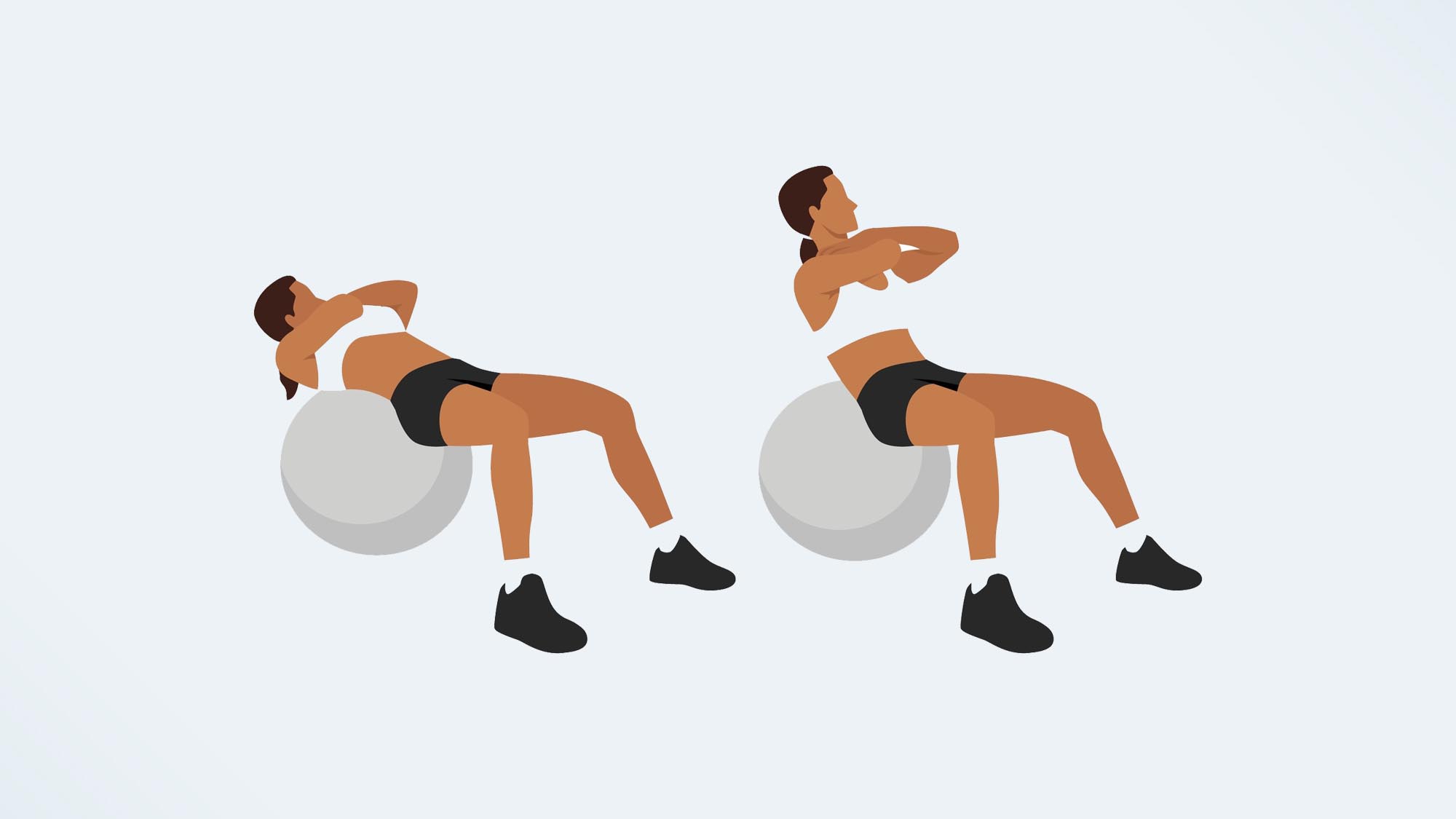
The most basic yet popular stability ball exercise, the crunch targets superficial core muscles like your rectus abdominis (or “six-pack”) while also activating your deeper core muscles to stabilize your body.
To perform the stability ball crunch, sit on top of a stability ball with your shoulders rolled back and spine neutral. Walk your feet in front of you and allow yourself to slowly roll down until your lower back is resting on and supported by the ball. Cross your arms at your chest, squeeze your abdominal muscles, and lift your head and shoulders up and away from the ball. Slowly lower yourself back down to the starting position. Continue for a set of 12-15 repetitions.
If you find your neck tensing throughout the exercise, place your hands behind your head for support. Avoid using your arms to pull your head and shoulders into the crunch — rely only on your abdominals for the movement. If your lower back begins to hurt, roll down a bit further on the ball and ensure that your spine is in a neutral position.
The stability ball crunch is excellent for beginners, but it can also be progressed for the more advanced exerciser. Try holding one of the best adjustable dumbbells, best kettlebells, or plate at your chest for an extra challenge.
2. Stability ball hack squat
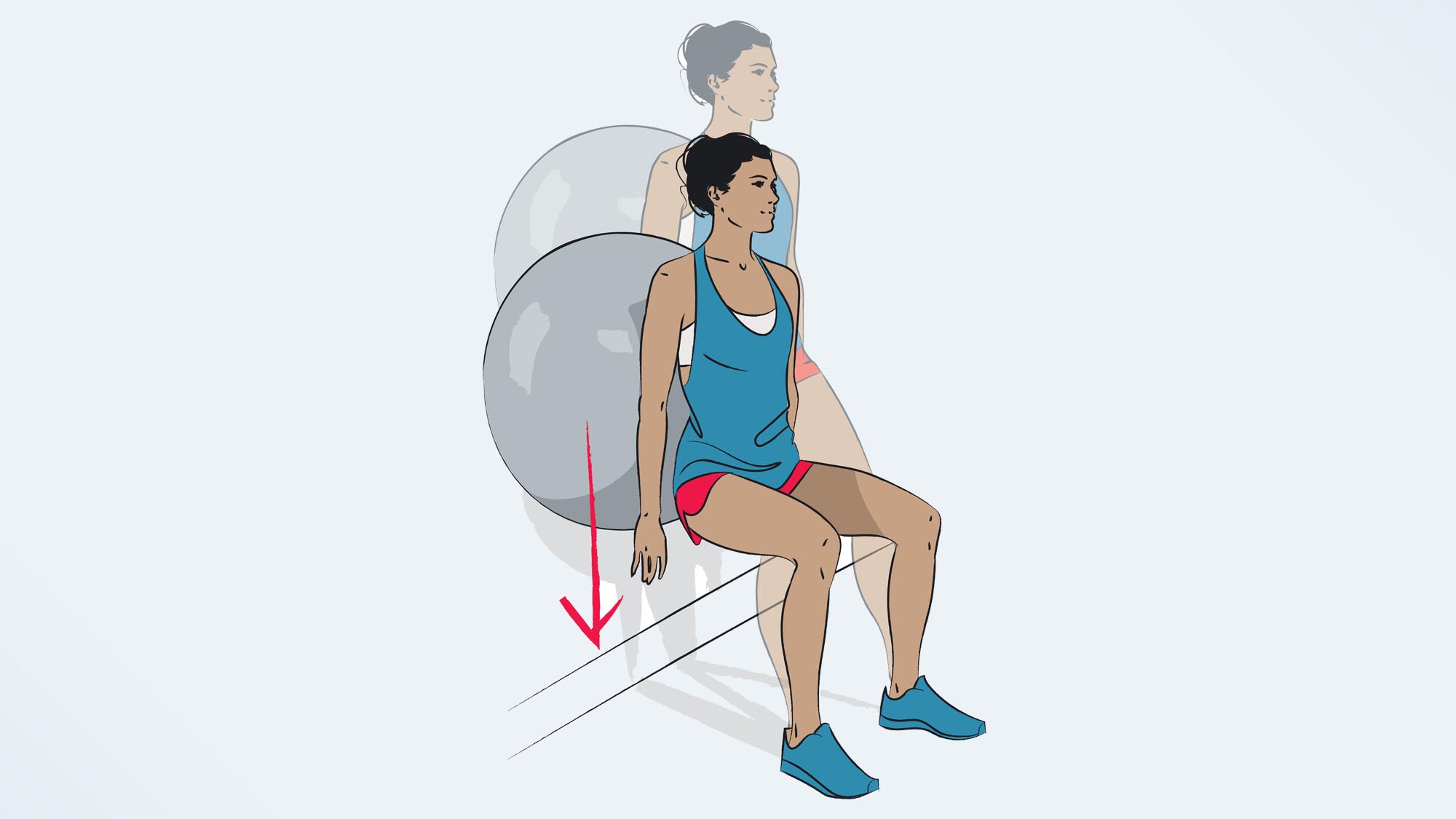
The stability ball hack squat is a great way to target your glutes, hamstrings, and quads. If back injuries or other considerations make regular squats out of the question, the stability ball hack squat can be an appropriate modification. As always — if you’re exercising with an injury, it’s best to meet with a certified personal trainer to ensure correct and safe form.
To perform the stability ball hack squat, place a stability ball against the wall, slightly above hip level. Lean back against the ball and align your lower back with the curve of the ball. Walk your feet out in front of you, at about shoulder-width apart. Roll your shoulders back and engage your core with a neutral spine. Bend your knees and lower your hips towards the floor. Once you’ve reached the end of your range, press through your feet and stand tall. Continue for a set of 10-12 repetitions.
For a more advanced option, grab a dumbbell or kettlebell and hold it in a goblet position, or grab two dumbbells or kettlebells and hold them at your sides as you perform the exercise.
3. Stability ball dead bugs
Dead bugs are one of the best exercises you can do to build deep core strength and endurance. Adding a stability ball into the mix will not only keep your form in check, but will also increase the dead bug’s difficulty.
To perform the stability ball dead bug, lie on the mat with a stability ball to your side. Grab the ball and hold it directly above you, aligned with your belly button. Lift your feet off the ground and align your knees over your hips in a table top position, with your legs bent at a 90 degree angle. Press the stability ball into your thighs. Elongate your arms and press your hands against the stability ball. Your arms and thighs should be framing the front and back of the ball. With your core engaged and your spine neutral, slowly lower your left arm and extend your right leg towards the mat, keeping your right arm and left thigh pressed into the ball. Once you’ve reached the end of your range, lift your left arm and right foot back to the starting position. Continue for a set of 12-15 repetitions, and then repeat on the opposite side.
If you find your lower back arching throughout the exercise, drop the stability ball and practice the dead bug without it. If you want to test your coordination, alternate reps between your two sides.
4. Stability ball hamstring curl
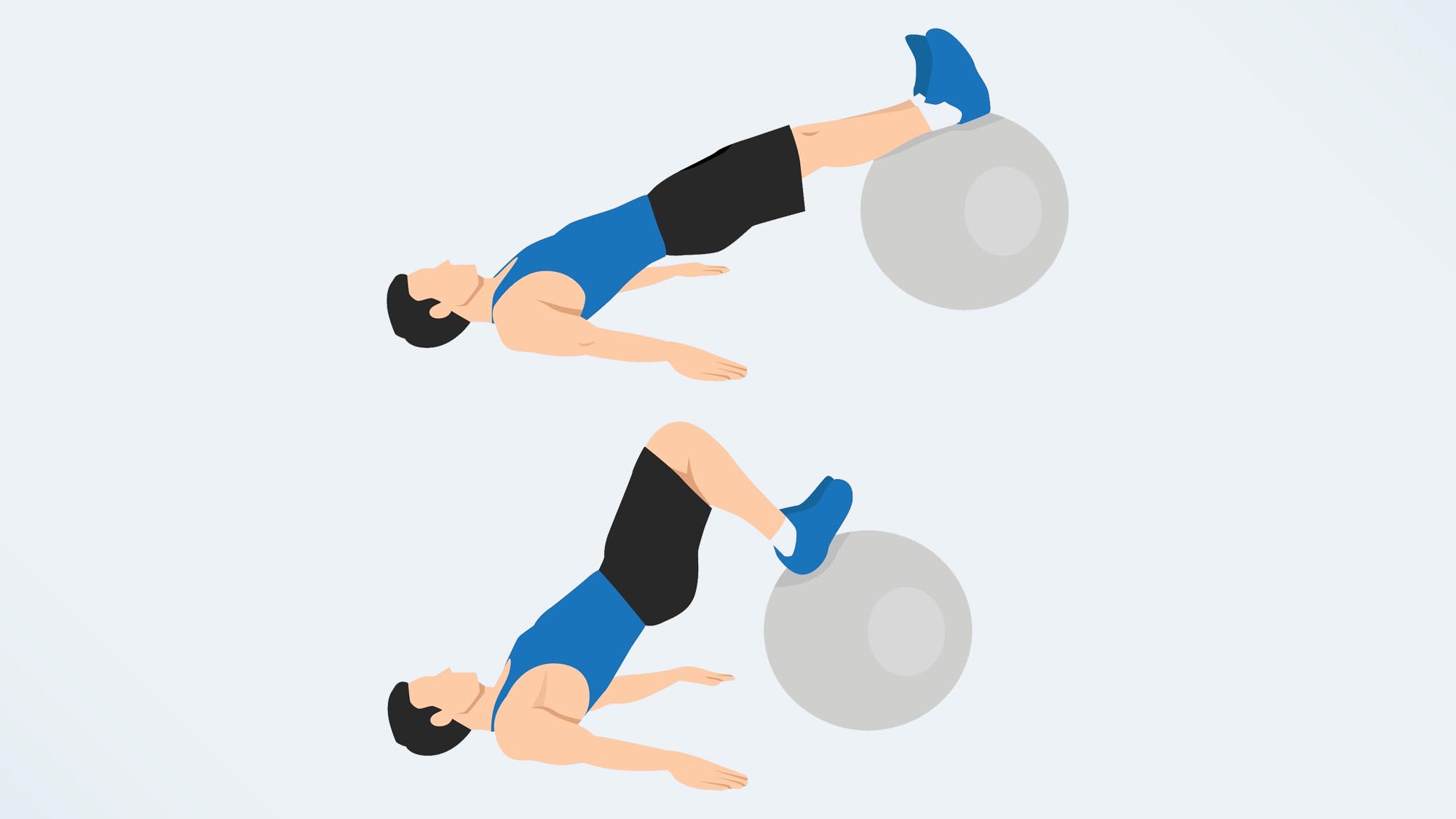
As the name implies, the stability ball hamstring curl works the hamstrings along with the glutes and core. Depending on the size and firmness of the ball, the hamstring curl can be used as a leg day warm-up or a more demanding strength and stability exercise.
To perform the stability ball hamstring curl, lie on your back with a stability ball at your feet. Lift your heels off the mat and place them on top of the ball. Engage your core, squeeze your glutes, and lift your hips off of the mat while keeping your spine in a neutral position. Squeeze your hamstrings and roll the ball towards your hips, bending at the knees. Slowly roll the ball back to the starting position by extending your legs. Continue for a set of 12-15 repetitions.
If you find your lower back arching during the exercise, practice a standard glue bridge with good form first before progressing to the stability ball hamstring curl.
5. Stability ball roll outs
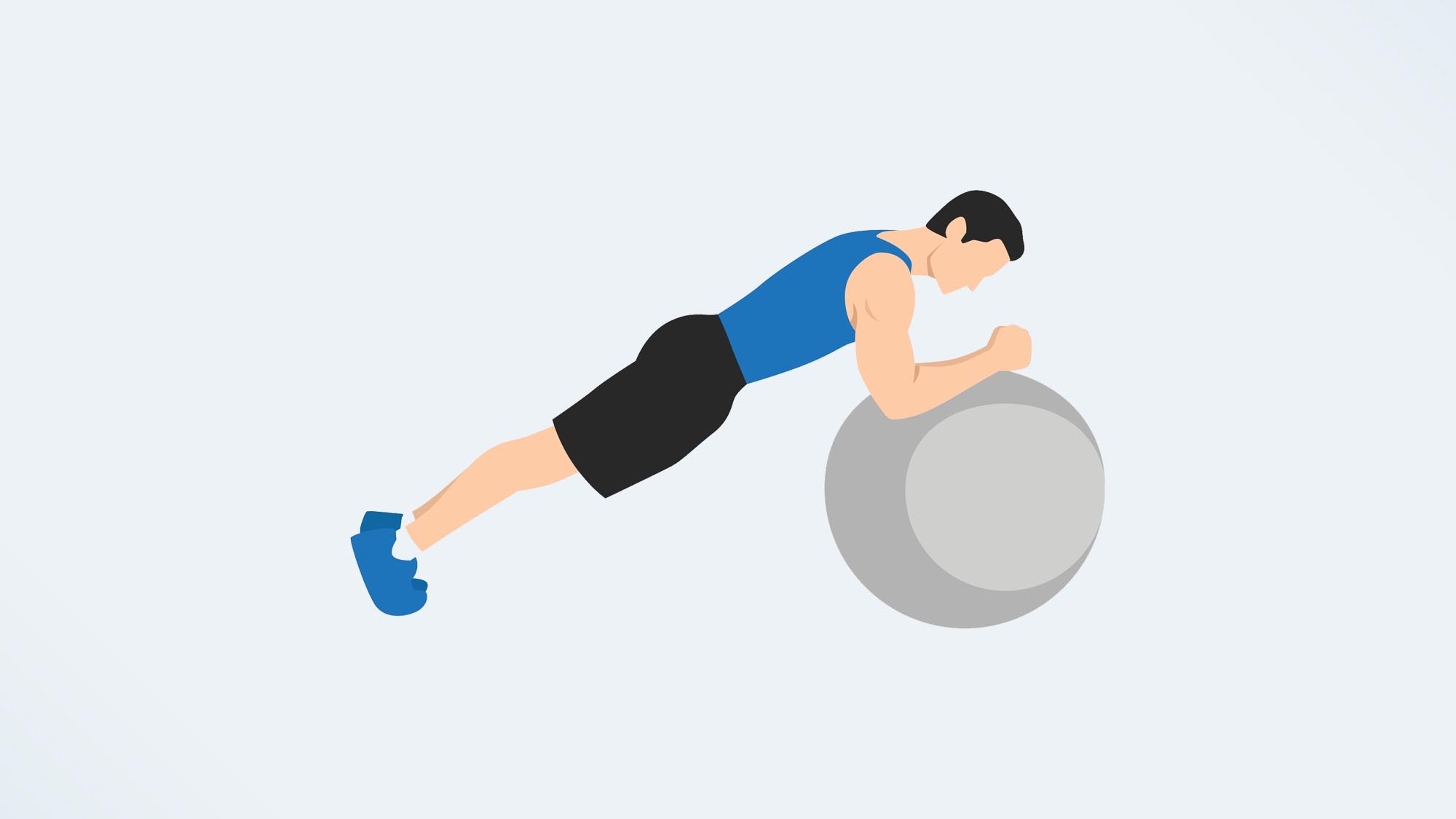
If your planks have been feeling a bit easy lately, you might be ready for stability ball roll outs. This isn’t an exercise for total gym novices, however there are ways to modify it if you’re ready for a challenge.
To perform stability ball roll outs, come to a kneeling position on the mat with a stability ball in front of you. Place your forearms on top of the ball, with your elbows aligned under your shoulders. Step your feet back and place your toes on the mat behind you, lengthening your legs, hovering your hips over the mat, and keeping your spine in a neutral position. With your core engaged and your plank form steady, slowly roll the ball away from you. Don’t allow your hips to drop towards the floor. Roll the ball back to the starting position. Continue for a set of 8-10 repetitions.
If you’re “roll out-curious” but a little intimidated, you can perform the exercise on your knees as an alternative. This is also a modification you can take if your lower back arches during the exercise. If the roll out feels too rudimentary, you can swap it for a stability ball “stir the pot” — instead of rolling the ball directly in front of you, make small circles with the ball in each direction.
6. Stability ball push-up

There are a million and one ways to vary the push-up — some are easier than the standard form, and some are harder. The stability ball push-up falls into that latter category, so make sure your regular push-ups are solid before adding anything extra.
To perform the stability ball push up, come to a kneeling position on the mat with a stability ball behind you. Place both of your hands on the mat, aligned directly underneath your shoulders, with your arms straight. Lift your right knee off the mat, elongate the right leg, and place your right foot on top of the stability ball behind you. Follow with the left leg. With both feet on the ball, an engaged core, and a neutral spine, bend your elbows and slowly lower your chest towards the mat. Once you’ve reached the end of your range, straighten your arms and push yourself back up to the starting position. Continue for a set of 10-12 repetitions.
If you think you’re “in between” regular push-ups and stability ball push-ups, place your upper thighs on top of the ball as opposed to your feet. If you’ve been wanting to improve your shoulder stability, perform the push-up with your hands on the ball and your feet on the mat in an inclined position.
7. Stability ball pikes
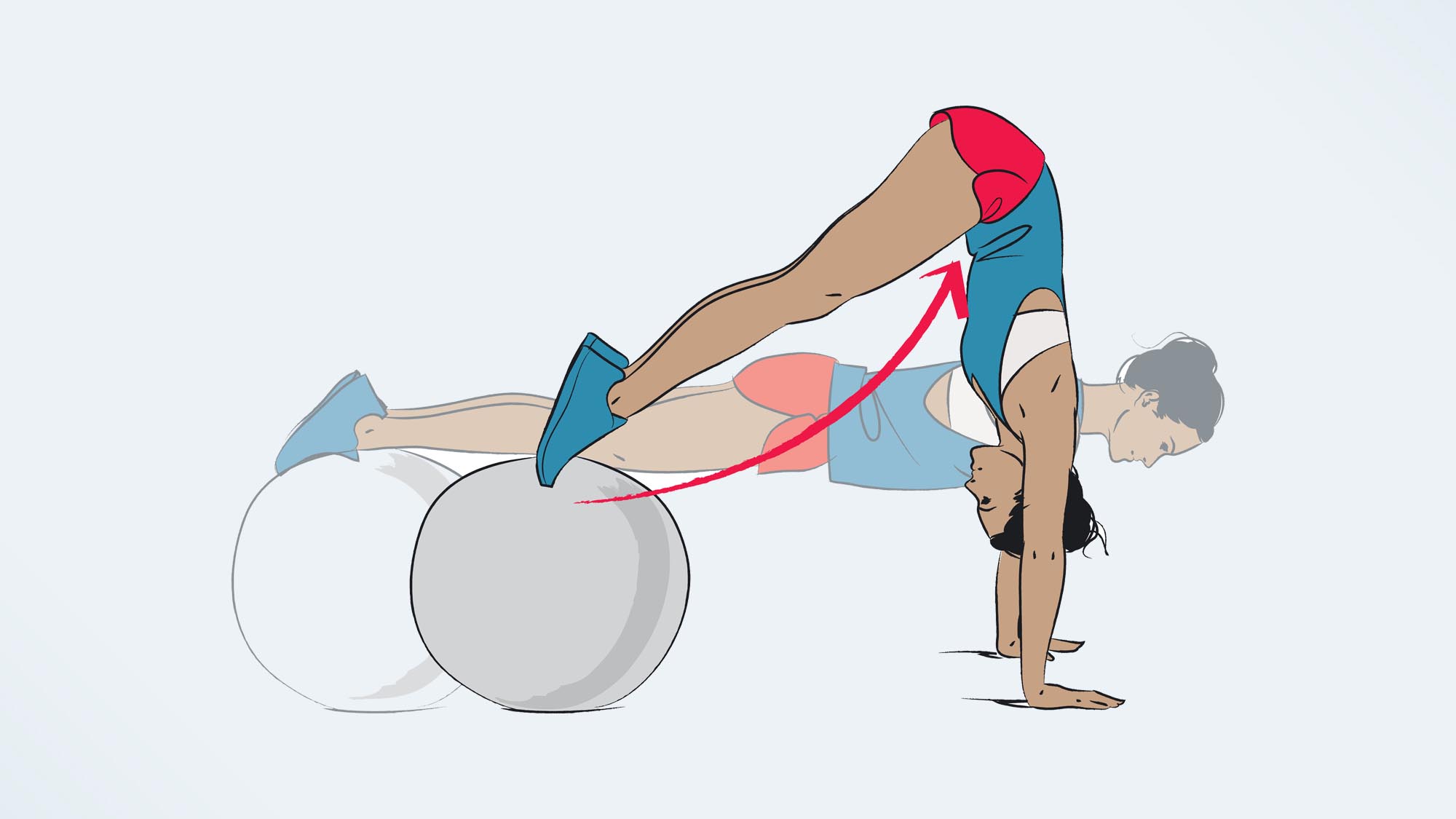
The stability ball pike is not for the faint of heart. It’s also not for beginners. But if you’re no stranger to exercise and your usual core work has gotten rather stale, then stability ball pikes are a good way to bring some formidable variety to your routine.
To perform the stability ball pike, come to a kneeling position on the mat with a stability ball behind you. Place both of your hands on the mat aligned directly underneath your shoulders, with your arms elongated. Lift your right knee off the mat, extend your right leg, and place your right toes on the ball behind you. Keep your foot in a flexed position. Follow with your left leg. With both toes on the ball and your core engaged, slowly lift your hips into the air and allow the ball to roll slightly forward. Keep your legs locked — don’t bend at the knees. Lower your hips to the starting position, rolling the ball back as your hips drop. Continue for a set of 8-10 repetitions.
If you’re not ready for the pike but past the basic core exercises, you can try a stability ball knee tuck as a substitute — place your shins on top of the ball instead of your toes, bend your knees, and pull them forward towards your chest. You can also build up to the pike by getting into the starting position, with your toes on the ball and your hands on the mat, and hold that form for 30-45 seconds.
More from Tom's Guide
Jennifer Rizzuto is a freelance writer and certified personal trainer based in Long Island, NY. She covers various fitness-related topics and reviews for Tom's Guide. She also writes sketch comedy and short films, and performs frequently as an actor, singer, and improviser. When she's not writing, working out, or performing, you'll find her trying to convince her husband to get a dog.

